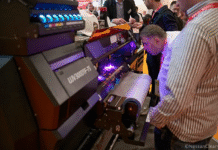Agfa has announced that its Anuvia 1250/1551 and Anapurna1200/1501 UV LED inkjet inks sets for sign and display printing received the GREENGUARD Gold certification in recognition of their environmental friendliness.
The GREENGUARD certification is granted to products that meet some of the world’s most rigorous chemical emissions standards, helping to reduce indoor air pollution and the risk of chemical exposure. The GREENGUARD Gold standard includes health-based criteria for more than 360 VOCs and also requires lower total VOC emission levels to ensure that the products are acceptable for use in sensitive indoor environments like schools and healthcare facilities.
Agfa Anuvia 1250 and 1551, as well as the Anapurna 1200 and 1501 inkjet ink sets, obtained the highest level within the GREENGUARD Gold certification, which means that they are perfectly safe to be used for prints that cover all walls of a room – not just as signage or partial wall decoration.
“Obtaining the GREENGUARD Gold certification for our wide format UV LED inkjet inks underlines our commitment to offer printing systems that are safe and environmentally friendly,” says Sarah Lafleur, application product manager – Inkjet Ink. “Print businesses investing in an Anapurna or Jeti wide format printer from Agfa enjoy both operator safety and the opportunity to generate additional business as they can meet their customers’ requests for a certified solution for wall finish applications.”
If you are satisfied with your sales, you probably don’t need us!
If you are happy with your equipment, consumables, and software sales to Indian printers, you probably don’t need us. But if you want to grow your sales or improve your marketing, then talk to us. Our research and consulting company, IppStar can assess your potential and addressable markets in light of the competition. We can discuss marketing, communication, and sales strategies for market entry, and for market growth.
For suppliers or service providers with a strategy and budget, I suggest you talk to us about using our hybrid print, web, video, and social media channels to impact your product communication. We are one of the world’s leading B2B publications in the print industry with hands-on practitioner and consulting experience – an understanding of business and financials, and some of the best technical writers. Our young team is ready to travel to meet you and your customers for content.
India’s fast-growing large economy has considerable headroom for print. Get our 2025 media kit and recalibrate your role in this dynamic market. Enhance your visibility and relevance to existing markets and turn potential customers into conversations.
Founded in 1979 as a technical newsletter, Indian Printer and Publisher is the oldest B2B trade publication in the multi-platform and multi-channel IPPGroup. IppStar [www.ippstar.org] is our Services, Training and Research organization.
Naresh Khanna – 20 January 2025
Subscribe Now
















